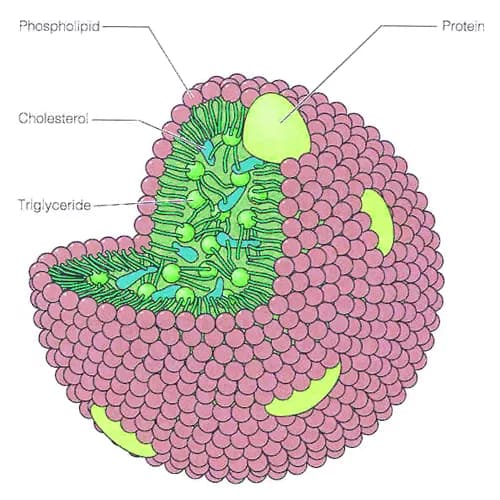LDL stands for low-density lipoproteins, which are remnants of lipoprotein particles released by the liver. There are three types of lipoprotein particles that are distinguished by their density, contents, and functions. The three types are very low-density lipoproteins (VLDLs), low-density lipoproteins (LDLs), and high-density lipoproteins (HDLs).
When a high fat meal is ingested, the majority of the fats (triacylglycerols) are broken down in the small intestine by bile salts released by the pancreas. Once broken down into free fatty acids, they are absorbed through the intestinal walls and repackaged again as triacylglycerols into particles called chylomicrons. Chylomicrons mostly contain triacylglycerols and cholesterol. These particles are released into the lymphatic system and eventually enter the bloodstream. In blood vessels, fatty acids are released by enzymes and taken up by cells to be used as fuel. The remnants of the chylomicrons enter the liver, which absorbs the remaining fat and cholesterol.
Once the fat and cholesterol is taken up by the liver, it is stored until the body needs energy between meals or during fasting. Fats and cholesterol are sent back into the bloodstream by the liver in VLDLs. VLDLs have the lowest density, but the highest percentage of fats inside. Once enzymes release fats from VLDLs for use as energy, they turn into LDLs. LDL cholesterol has the second lowest density, but the highest percentage of cholesterol. When there are normal levels of LDL in blood, they help deliver cholesterol to cells to be used for many different important functions. However, if LDL levels are too high, then the lipoproteins can stick together outside artery walls. This can activate immune cells that try to clear them away. If the immune cells (macrophages) take up too much cholesterol, they can die and damage nearby vessel walls. Additionally, the cells, along with the cholesterol they contained, can form plaques on the vessel wall, which can lead to blockages. This is why LDL is also known as “bad” cholesterol.
Plaque buildup is also known as atherosclerosis. The buildup of plaque in arteries narrows their diameter and obstructs blood flow. The signs of atherosclerosis can become more severe over time. If a blood vessel to the heart becomes completely blocked, it can cause a heart attack. If a blood vessel in the brain is blocked, it can cause a stroke. Blockages in other arteries can cause pain or swelling in different areas of the body, as well as tissue damage due to a lack of blood flow. This risk of developing atherosclerosis is increased by diets high in fat and cholesterol, smoking, high blood pressure, diabetes, obesity, and a sedentary lifestyle.
HDL is known as “good” cholesterol because it is sent out by the liver to collect cholesterol from the blood stream to bring back to the liver, adrenal glands, and gonads. This helps to reduce circulating cholesterol and prevent plaque buildup and heart disease. While high levels of LDL are associated with heart disease, high levels of HDL cholesterol are associated with lowered risks.
Atherosclerosis can be prevented by making changes to one’s diet and exercising more. By eating a diet lower in saturated fats and cholesterol, it can help lower the LDL levels. Exercising can help lower the amount of fat circulating in the bloodstream, lower cholesterol levels, and reduce weight.
Smoking puts one at a higher risk for atherosclerosis; so quitting is an important part of lowering the risk and improving one’s overall health. In the case of diabetes, a proper management of blood sugar levels is important for preventing heart disease. Finally, avoiding foods high in cholesterol and regular checkups with one’s health provider can ensure that cholesterol levels are properly managed and any sign of atherosclerosis is caught as early as possible. People with unmanageable cholesterol may need to be prescribed medications to prevent cholesterol buildup and promote normal cholesterol levels.
References:
http://www.urmc.rochester.edu/encyclopedia/content.aspx?ContentTypeID=1&ContentID=1583 (accessed on December 24, 2014)
http://www.uchospitals.edu/online-library/content=P00197 (accessed on December 24, 2014)
http://www.cdc.gov/cholesterol/ldl_hdl.htm (accessed on December 24, 2014)
"Lehninger Principles of Biochemistry, Sixth Edition" by Nelson and Cox W. H. Freeman Publishing, 2012
Helpful Peer-Reviewed Medical Articles:
Donnelly, K. L., Smith, C. I., Schwarzenberg, S. J., Jessurun, J., Boldt, M. D., & Parks, E. J. (2005). Sources of fatty acids stored in liver and secreted via lipoproteins in patients with nonalcoholic fatty liver disease. The Journal of clinical investigation, 115(5), 1343-1351.
Takeuchi, O., Sato, S., Horiuchi, T., Hoshino, K., Takeda, K., Dong, Z., ... & Akira, S. (2002). Cutting edge: role of Toll-like receptor 1 in mediating immune response to microbial lipoproteins. The Journal of Immunology,169(1), 10-14.
Takeuchi, O., Kawai, T., Mühlradt, P. F., Morr, M., Radolf, J. D., Zychlinsky, A., ... & Akira, S. (2001). Discrimination of bacterial lipoproteins by Toll-like receptor 6. International immunology, 13(7), 933-940.
Cnop, M., Havel, P. J., Utzschneider, K. M., Carr, D. B., Sinha, M. K., Boyko, E. J., ... & Kahn, S. E. (2003). Relationship of adiponectin to body fat distribution, insulin sensitivity and plasma lipoproteins: evidence for independent roles of age and sex. Diabetologia, 46(4), 459-469.
Wang, N., Lan, D., Chen, W., Matsuura, F., & Tall, A. R. (2004). ATP-binding cassette transporters G1 and G4 mediate cellular cholesterol efflux to high-density lipoproteins. Proceedings of the National academy of Sciences of the United States of America, 101(26), 9774-9779.
Kraus, W. E., Houmard, J. A., Duscha, B. D., Knetzger, K. J., Wharton, M. B., McCartney, J. S., ... & Kulkarni, K. R. (2002). Effects of the amount and intensity of exercise on plasma lipoproteins. New England Journal of Medicine, 347(19), 1483-1492.
Vickers, K. C., Palmisano, B. T., Shoucri, B. M., Shamburek, R. D., & Remaley, A. T. (2011). MicroRNAs are transported in plasma and delivered to recipient cells by high-density lipoproteins. Nature cell biology, 13(4), 423-433.
Related Articles
Test Your Knowledge
Asked by users
Related Centers
Related Specialties
Related Physicians
Related Procedures
Related Resources
Join DoveHubs
and connect with fellow professionals


0 Comments
Please log in to post a comment.